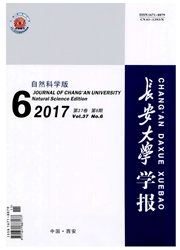

 中文摘要:
中文摘要:
随着强制性碳排放量控制目标的确立,如何通过路径优化实现区域农产品配送系统的节能减排,已成为刻不容缓的问题。为了实现区域农产品配送系统的节能减排,提出融合PM2.5排放量和运输路程的区域农产品配送路径决策方法。首先建立农产品配送系统中PM2.5排放量最少和运输路程最短的路径决策模型;然后提出基于相似性选择的演化算法,求解融合PM2.5排放量和运输路程的区域农产品配送路径决策问题,该算法避免了演化算法的早熟现象,提高了种群的多样性;针对配送过程中存在部分客户急需供货的情况,通过引入虚拟任务点建立满足这部分用户需求的路径决策模型;最后运用测试实例验证了所提出算法的有效性,并给出满意度指标来衡量算法的优越性。研究结果表明:与传统的蚁群算法和演化算法相比,基于改进演化算法的双目标路径决策不仅减小了PM2.5排放量,而且缩短了运输路程,满意度分别提高了约2.3%和1.4%;针对满足急需供货客户需求的双目标路径决策,虽然增加了PM2.5排放量和运输路程,但能及时满足这部分客户的需求,并且满意度也提高了约1.9%和2.7%。提出的算法降低了PM2.5排放量,缩短了运输路程,可为农产品配送车辆调度服务提供参考。
 英文摘要:
英文摘要:
With the establishment of mandatory carbon emissions control targets, it has become an urgent objective to implement the emissions reduction of regional agricultural products distribution through the path optimization. To agricultural products distribution, a hi-object path products distribution was proposed with the fusion of achieve the emissions reduction of regional decision-making method of regional agricultural least PM2.5 emissions and transportation distance.Firstly, a path decision-making model of PM2.5 emissions and transportation distance was constructed. To solve the model, a similarity-based selection hi-objective evolutionary algorithm was put forward, which could not only avoid the premature phenomenon of the traditional evolutionary algorithm, but also could improve the diversity of population. Meanwhile, for the urgent need of some customers during the distribution process, a bi-object path decision-making model based on the requirements of customers was established by introducing virtual task points. Finally, the proposed algorithm was verified by test example, and a satisfaction index was proposed to assess the superiority of the algorithm. The results show that the proposed algorithm can not only reduce PM2.5 emissions but also shorten the transportation distance. Compared with the traditional ant colony algorithm and evolutionary algorithm, satisfaction indexes of the proposed algorithm increase by about 2.3% and 1.4%, respectively. For the hi-object path decision- making with the urgent need of some customers, PM2.5 emissions and transportation distance increase, but the demands of customers are met in time. What's more, satisfaction indexes of the proposed algorithm increase by about 1.9% and 2.7%, respectively. In a word, the proposed method can reduce PM2.5 emission and transport distance, and can provide valuable suggestions to vehicle scheduling of the practical agricultural products distribution. 2 tabs, 4 figs, 17 refs.
 同期刊论文项目
同期刊论文项目
 同项目期刊论文
同项目期刊论文
 期刊信息
期刊信息
